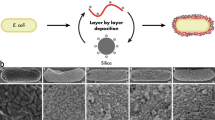Abstract
We examined the performance of methyltrimethoxysilane (MTMS), a precursor of silicic acid, in the process of biosilicification induced by the R5 peptide from Cylindrotheca fusiformis. Recombinant GFP-R5 fusion protein was produced by Escherichia coli cultured at 25°C as a soluble and functional formation, but not at 37°C. MTMS-based biosilica deposits had a larger average diameter compared to tetraethyl orthosilicate (TEOS)-based deposits. Reducing phosphate concentration in the buffer system led to a decrease in the size of MTMS-based biosilica. These results provide insight into the surface modification of biosilica, and control of biosilica particle size, when using hydrophobic precursors such as MTMS.
Similar content being viewed by others
References
Davis, M. E. (2002) Ordered porous materials for emerging applications. Nature 417: 813–821.
Sinkó, K. (2010) Influence of chemical conditions on the nanoporous structure of silicate aerogels. Materials 3: 704–740.
Jo, B. H., C. S. Kim, Y. K. Jo, H. Cheong, and H. J. Cha (2016) Recent developments and applications of bioinspired silicification. Kor. J. Chem. Eng. 33: 1125–1133.
Betancor, L. and H. R. Luckarift (2008) Bioinspired enzyme encapsulation for biocatalysis. Trends Biotechnol. 26: 566–572.
Lechner, C. C. and C. F. Becker (2014) A sequence-function analysis of the silica precipitating silaffin R5 peptide. J. Pept. Sci. 20: 152–158.
Jo, B. H., J. H. Seo, Y. J. Yang, K. Baek, Y. S. Choi, S. P. Pack, S. H. Oh, and H. J. Cha (2014) Bioinspired silica nanocomposite with autoencapsulated carbonic anhydrase as a robust biocatalyst for CO2 sequestration. ACS Catal. 4: 4332–4340.
Kuan, I.-C., C.-A. Chuang, S.-L. Lee, and C.-Y. Yu (2012) Alkyl-substituted methoxysilanes enhance the activity and stability of d-amino acid oxidase encapsulated in biomimetic silica. Biotechnol. Lett. 34: 1493–1498.
Gill, I. and A. Ballesteros (2000) Bioencapsulation within synthetic polymers (Part 1): sol–gel encapsulated biologicals. Trends Biotechnol. 18: 282–296.
Reetz, M. T. (1997) Entrapment of biocatalysts in hydrophobic sol-gel materials for use in organic chemistry. Adv. Mater. 9: 943–954.
Rao, A. V., S. D. Bhagat, H. Hirashima, and G. Pajonk (2006) Synthesis of flexible silica aerogels using methyltrimethoxysilane (MTMS) precursor. J. Colloid Interf. Sci. 300: 279–285.
Du, M., N. Mao, and S. Russell (2016) Control of porous structure in flexible silicone aerogels produced from methyltrimethoxysilane (MTMS): The effect of precursor concentration in sol–gel solutions. J. Mater. Sci. 51: 719–731.
Nam, D. H., K. Won, Y. H. Kim, and B. I. Sang (2009) A novel route for immobilization of proteins to silica particles incorporating silaffin domains. Biotechnol. Prog. 25: 1643–1649.
Park, J. C., G. T. Lee, C. S. Kim, and J. H. Seo (2017) Effects of surface charge and ligand type of Au nanoparticles on green fluorescent protein-expressing Escherichia coli. Biotechnol. Bioproc. Eng. 22: 83–88.
Kim, D. H., J. C. Park, G. E. Jeon, C. S. Kim, and J. H. Seo (2017) Effect of the size and shape of silver nanoparticles on bacterial growth and metabolism by monitoring optical density and fluorescence intensity. Biotechnol. Bioproc. Eng. 22: 210–217.
Song, Y. H., C. S. Kim, and J. H. Seo (2016) Noninvasive monitoring of environmental toxicity through green fluorescent protein expressing Escherichia coli. Kor. J. Chem. Eng. 33: 1331–1336.
Philipavičius, J., I. Kazadojev, A. Beganskienė, A. Melninkaitis, V. Sirutkaitis, and A. Kareiva (2008) Hydrophobic antireflective silica coatings via sol-gel process. Mater. Sci. 14: 283–287.
Sumper, M., S. Lorenz, and E. Brunner (2003) Biomimetic control of size in the polyamine-directed formation of silica nanospheres. Angew. Chem. In. Ed. 42: 5192–5195.
Kröger, N., S. Lorenz, E. Brunner, and M. Sumper (2002) Selfassembly of highly phosphorylated silaffins and their function in biosilica morphogenesis. Sci. 298: 584–586.
Author information
Authors and Affiliations
Corresponding author
Rights and permissions
About this article
Cite this article
Park, J.C., Kim, D.H., Kim, C.S. et al. R5 Peptide-based Biosilicification Using Methyltrimethoxysilane. Biotechnol Bioproc E 23, 11–15 (2018). https://doi.org/10.1007/s12257-017-0451-2
Received:
Revised:
Accepted:
Published:
Issue Date:
DOI: https://doi.org/10.1007/s12257-017-0451-2




